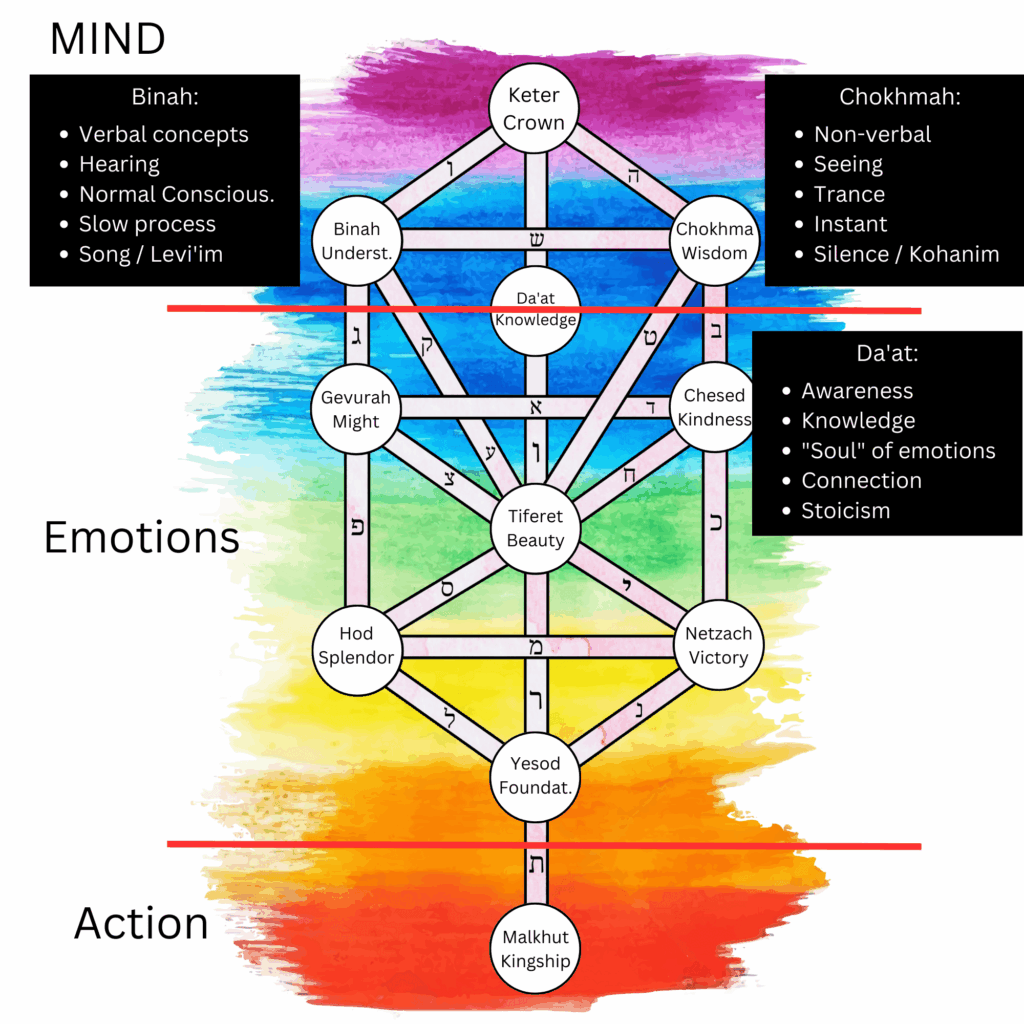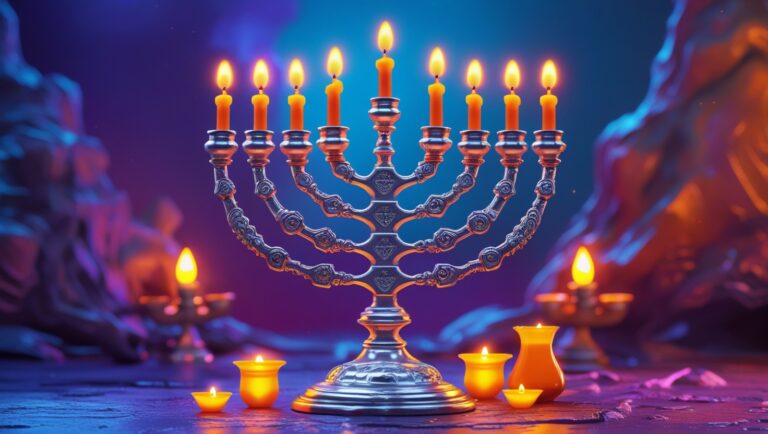The third Sefirah of Binah is often translated as “understanding,” but its true depth cannot be captured by this word alone.
Also called “Imma” (mother), this sephira is a spiritual womb that shapes, expands, and brings form to the sparks of wisdom that emerge from Chochmah, which is also called “Abba” (father). The implication is clear: Binah translates the divine insights from Abbah into a full fledged idea with all its details, much like a woman receives the seed from her husband and develops it into a baby.
As the Zohar teaches, “Binah is the quarry of the Torah” (Zohar III:179b). It is here that the raw point of Chochmah is hewn and expanded into the breadth of understanding that gives birth to spiritual realities. This is incredibly important to know because our goal in Kabbalah Meditation is to often transcend the insights of Binah and go into the ethereal state of Chokhmah.
However, it is not merely intellectual. It is a creative, nurturing force that transforms flashes of divine wisdom into structured, embodied awareness. And it also bridges the gap between the transcendent and the immanent, making the infinite accessible to the soul.
Before we move forward, be sure to check out the previous articles on the Tree of Life series:
- Sephira of Keter
- Sephira of Chokhmah
- Sephira of Binah
- Sephira of Da’at
- Sephira of Chessed
- Sephira of Gevurah
- Sephira of Tiferet
- Sephira of Netzach
- Sephira of Hod
- Sephira of Yesod
- Sephira of Malkhut

Inside the Mystical Tree of Life
Binah as the root of all middot (emotional attributes)
Rabbi Chaim Vital writes in Eitz Chaim (Shaar HaKelalim, ch. 1) that Binah is the root of all emotions (middot), because through its process of contemplation and depth, it brings awareness that stirs the heart. As you saw in the image above, it is the one that “gives birth” to the 7 emotions (Chesed, Gevurah, Tiferet, Netzach, Hod and Yesod).
This power of the soul is also the realm of imagination, which in turn gives birth to new insights, if used properly. We should never dismiss our thoughts as mere “meanderings” of the mind. They are present and real in the spiritual realms, and it is often through them that we perceive higher messages.
Rabbi Avraham Abulafia deepens this understanding by teaching that it also corresponds to the power of hitbonenut (meditative contemplation). In Otzar Eden HaGanuz he writes that true comprehension in Binah comes through disciplined contemplation of the Divine Name, which opens the mind to new dimensions of reality.
Binah as the source of Teshuvah
The connection between Binah and Teshuvah is drawn from Zohar III: 122a (Parashat Pinchas):
“בינה — תשובה היא”
“Binah is Teshuvah.”
The Zohar also links this to the verse “Return, O Israel, to Hashem your G-d” (Hoshea 14:2), explaining that Teshuvah involves returning the soul to its root in Binah Ila’ah (the higher mother).
Furthermore, the Arizal in Shaar HaTeshuvah (in Pri Etz Chaim, Shaar 4) writes that the essence of Teshuvah is to restore the soul from the grasp of the Sitra Achra and realign it with Binah, the source of purification and rectification. Since it is the Supernal Mother, it has the power to birth the soul anew in holiness and this state is most readily available on Yom Kippur, when the Partzufim of Zeir Anpin and Nukvah rise to there.
In this light, one can understand why sincere Teshuvah is not only about remorse but about “being born again” spiritually. The person, through deep contemplation (a Binah process), disentangles their soul from the dinim and impurities attached to it, and allows it to be reabsorbed into the purifying womb. The same process can also happen with proper Kavanot before one goes to sleep.
This sheds light on the custom to meditate on the Divine Name Yud-Heh-Vav-Heh during Teshuvah, focusing on the first Heh, to draw oneself back into the source of compassion and cleansing.

Binah as the first Heh of the Divine Name
The Arizal writes clearly in Eitz Chaim (Shaar 1, Anaf 2):
“י׳ — חכמה, ה׳ ראשונה — בינה…”
“The Yud is Chochmah, the first Heh is Binah…”
As we know, everything follows the pattern of the divine name of יהוה. The first Heh of the Tetragrammaton (Yud-Heh-Vav-Heh) represents Binah, as it is the vessel that expands the Yud (the point of Chochmah) into length and breadth. Just as the Heh has both height and width, so too does Binah expand the concealed light into understanding and elaboration. It is also shaped like a womb with the opening below.
The manifestation of dinim
There’s a principle from the Zohar that when Ein Sof created the spiritual worlds, it used the power of “dinim” (Judgments), in order to give limits to it. We often perceive them as bad, but they are simply a necessary component of Creation. Check out this article on dinim.
- Dinim inside Keter are hidden by its all-encompassing compassion.
- Dinim inside Chokhmah can be perceived but it is resting like the wine sediments at the bottom of a barrel.
- However, Dinim inside Binah become aroused and we can very much see it.
This idea is rooted in the Zohar, Parashat Mishpatim (Zohar II: 179b), which says:
“ומבינה מתערין דינין, ומתמן נפקין כולא”
“From Binah, judgments are aroused, and from there they emerge.”
This is explained at length by the Arizal in Eitz Chaim (Shaar 8, Derush 5 on Ima Ila’ah). The concept is that while Chochmah is pure light and unbounded flow, in Binah the light begins to take form, and with form comes boundaries, which is the root of din (judgment).
This also explains why in marriage, it is often the man (Abba/Chokhmah) who’s more easy-going, and women (Imma/Binah) are more hot-tempered. This obviously doesn’t mean one is better than the other or that there aren’t exceptions, but it is a general rule. Excessive easy going-ness can translate into laziness and apathy, but a hot-temper person can also utilize his emotions to propel himself closer to Hashem. It all depends how we use our traits.
Fascinatingly though, the Arizal teaches in Eitz Chaim (Shaar 34, Derush 2):
“והנה בינה היא סוד מיתוק הדינין.”
“Behold, Binah is the secret of the sweetening of judgments.”
This is an extraordinary insight. Although Binah is the source of dinim, it also holds the key to their sweetening. Why? Because the judgments that emerge from Binah are not rooted in harshness but in clarity and discernment.
Through proper contemplation and alignment with Binah, a person can sweeten the judgments upon them by perceiving their purpose and by realigning with Divine wisdom. This is why meditative Teshuvah (associated with Binah) transforms not only the person’s future actions but also mitigates decrees already set in motion.
For more information on the Sephira of Binah and its related terms, check out this article.







